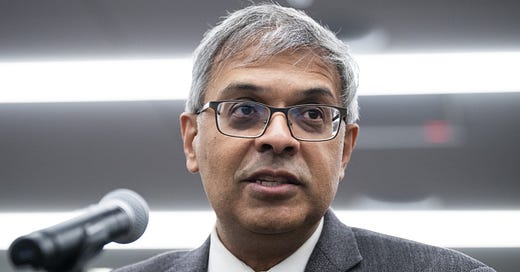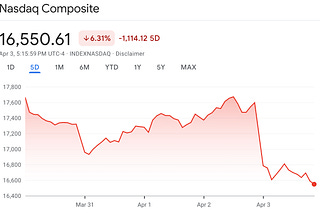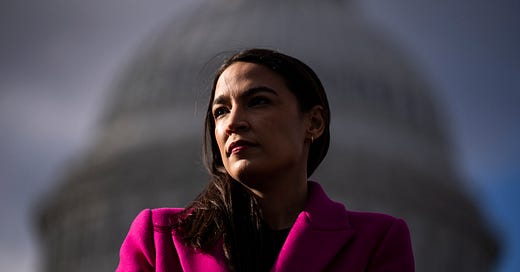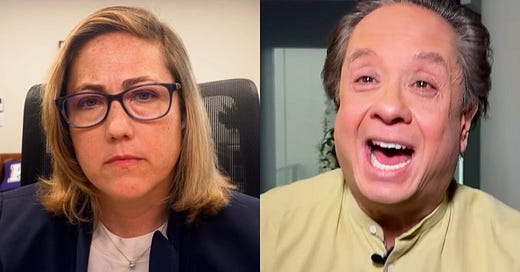

DONALD TRUMP’S ANNOUNCEMENT last month of Stanford professor Dr. Jay Bhattacharya as his nominee to be the next director of the National Institutes of Health further intensified the controversy—and alarm—about what the second Trump administration will mean for American science and medicine. Consider the nominees for the most prominent federal health posts: Bhattacharya at the NIH, Robert F. Kennedy Jr. as secretary of health and human services, former Florida Congressman Dr. David Weldon at the CDC, Johns Hopkins professor Dr. Marty Makary at the FDA, and former Fox News personality Dr. Janette Nesheiwat as surgeon general. This is, unmistakably, a takeover of the public health establishment by COVID-19 contrarians—or, if you prefer, by COVID cranks.
Unlike RFK Jr., a longtime, all-around conspiracy theorist with no medical background, Bhattacharya is an actual physician. He also has a Ph.D. in economics, and a track record of reputable scholarship focusing on policy questions related to public health. But there is no question that Bhattacharya owes his nomination to one thing: his emergence early in the COVID pandemic as a vocal critic of the public health consensus that favored social distancing to mitigate the spread of the virus. Bhattacharya was one of the three co-authors of the “Great Barrington Declaration,” an October 2020 statement that called for “focused protection” for the elderly and other vulnerable groups while letting the virus spread through the rest of the population until herd immunity was reached.
At the time, most scientists thought it was a terrible idea. Among them was then-NIH director Dr. Francis Collins; a few days after the statement was posted, he emailed National Institute of Allergy and Infectious Diseases director Dr. Anthony Fauci, referring to Bhattacharya and his colleagues as “fringe epidemiologists” and suggesting “a quick and devastating published take down” of the statement. Bhattacharya, who later obtained that email via the Freedom of Information Act, told a congressional subcommittee in March 2023 that he and his colleagues were “targeted for censorship” and “targeted for suppression by federal officials” because their arguments were a threat to the establishment’s “illusion” of scientific consensus.
Is Bhattacharya’s claim of broad censorship true? Some internet companies clearly did move to reduce his reach because he was classified as a purveyor of COVID misinformation: Twitter kept his name from trending and Google may have sometimes suppressed or downgraded the Great Barrington Declaration website in its search results. But the persecution narrative leaves out other relevant facts—for instance, that Bhattacharya found champions in senior health officials in the first Trump administration and later advised Florida Gov. Ron DeSantis, or that he gained a regular platform in conservative media, such as the Wall Street Journal opinion page.
TODAY, THERE’S A WIDESPREAD BELIEF on the right that Bhattacharya and his co-authors have been proven right in their critique of the lockdowns. Some of their views, such as the opposition to school closures, are indeed now widely accepted. (For what it’s worth, the right’s bogeyman, Dr. Fauci, argued as early as spring 2020 for reopening schools that fall, except in areas with active outbreaks.) But the Great Barrington Declaration’s larger view of how to deal with the pandemic is far from vindicated, as science writer David Wallace-Wells explained last month in the New York Times.
For one thing, Bhattacharya and his colleagues consistently lowballed COVID-19’s toll and fatality rates from the start. A March 2020 Wall Street Journal column co-authored by Bhattacharya argued that the virus was probably much less deadly than was being claimed and that it was likely to kill 20,000 to 40,000 Americans, on a par with the seasonal flu. (This was, of course, fully accordant with Trump’s own tendency to downplay and minimize the danger of the virus and to compare it to the flu.) The actual death toll by now is over 1.2 million.
Bhattacharya has recently claimed that the March 2020 column was merely describing a “range of possible outcomes”; but in fact, it explicitly stated that the low estimates were “not only plausible but likely” while the higher ones were “severely flawed.” And Bhattacharya’s pattern of minimizing the danger continued after that. By early 2021, COVID deaths in the United States stood at over 330,000, exceeding his “likely” projections by an order of magnitude. In January, he advised against mass vaccination in India, arguing that most of the population had already been infected and acquired natural immunity. About a month later India became the center of the Delta variant of COVID-19, which killed a quarter million people just between April and July. In late June 2021, Bhattacharya and Great Barrington Declaration co-author Martin Kulldorff wrote in the Wall Street Journal that the pandemic was “on its way out” in the United States; since then, it has claimed some 700,000 more American lives.
The strategies outlined in the Great Barrington Declaration were thus based on extremely flawed estimates. In a detailed analysis published in March 2022, Australian epidemiologist and science writer Gideon Meyerowitz-Katz concluded that while “focused protection of the vulnerable” sounded great in theory, the actual proposals were “a sham.” Above all, the authors never came up with any plausible plan to protect people at high risk—not only seniors but millions of younger people with comorbidities ranging from asthma to obesity to a weakened immune system—while allowing low-risk people in the same households to live “normally.” Among other things, they suggested that vulnerable people could be temporarily housed with relatives and friends who are in quarantine, or in “empty hotel rooms.” But such an approach simply wasn’t feasible. The COVID contrarians tell us the lockdowns were inhumane, but imagine telling a recovering cancer patient to move into a hotel so that other family members can continue going about life as usual.
Add to this the fact that, as we now know, infection does not confer lasting, strong immunity against new COVID variants, making herd immunity an ever-receding mirage. Add, too, that deaths are not the only metric of damage from COVID; many people who recover are left with various forms of long-term health damage. All in all, it’s abundantly clear that the Great Barrington proposals were unworkable.1 And it’s far from clear that they would have helped avoid or mitigate the economic damage from the pandemic: By April 2021, Florida, which had reopened quickly, had lost almost as many businesses as locked-down California and New York—and more than locked-down Minnesota.
Revisiting the debate over the Great Barrington Declaration in 2022, libertarian economist Tyler Cowen summarized “three actions that endangered the vulnerable rather than protecting them”:
“Publishing papers suggesting a very, very low Covid-19 mortality rate, and then sticking with those results in media appearances after said results appeared extremely unlikely to be true.”
“Maintaining vague (or in some cases not so vague) affiliations with anti-vax groups.”
“Not having thought through how ‘herd immunity’ doctrines might be modified by ongoing mutations.”
It was a scathing verdict on Bhattacharya and his fellow COVID contrarians that remains relevant today.
IT MUST BE EMPHASIZED AGAIN that Bhattacharya is no RFK Jr. He’s an actual physician, not a guy who thinks that 5G networks are used to control behavior and Bill Gates wants to implant us all with microchips.
“I have respect for Jay,” Yale University social scientist and physician Nicholas Christakis, whose October 2020 book Apollo’s Arrow was a widely acclaimed early assessment of the impact of COVID-19, told me in a telephone interview. “In the early days of the pandemic, scientists were trying to figure out what was going on and trying to make policy recommendations based on sound science and sound precedent,” says Christakis, who largely supported and still supports the “establishment’s” initial pandemic mitigation strategies. “The fact that some people got it wrong is not to their discredit; this is how science works. I think that Jay is a serious person who’s extremely well trained and well qualified. I didn’t agree then with some of the ideas and claims he was advancing, and I don’t agree with them even in retrospect, but I do agree with other points he was making. I think the NIH will be in capable hands.”
Christakis also objects to the fact that “many of [Bhattacharya’s] antagonists, instead of refuting his claims, tried to silence him.” And indeed, looking back, it seems clear that trying to reduce the COVID contrarians’ online reach instead of more aggressively promoting rebuttals was a misguided approach—both on principle and because it probably boosted interest in their ideas and gave them the cachet of persecuted dissidents. Nonetheless, without disputing Bhattacharya’s credentials, there is good reason to be concerned by his refusal to admit that his estimates were badly wrong and that the Great Barrington proposals remain out of the mainstream.
Christakis thinks that in the next Trump administration, Bhattacharya will face “a difficult environment for sober-minded scientists to work when you have a person with RFK Jr.’s views and lack of pertinent experience heading the agency.” Yet, disturbingly, Bhattacharya co-wrote a panegyric to RFK Jr. a week after the election, hailing him as a “disruptor” while mocking “establishment mandarins who focus on his sometimes eccentric scientific claims.” Such glib dismissal of entirely justified criticisms of Kennedy’s quackery—and equally glib understatement of Kennedy’s profound unfitness for the job for which he has been nominated—speaks ill of Bhattacharya’s judgment.
ONE ISSUE ON WHICH RFK JR. is almost certainly united with Bhattacharya—and probably most of Trump’s other health agency picks—is anger about being marginalized as COVID cranks during the pandemic. Will this translate into, as Benjamin Mazer suggests in the Atlantic, “revenge” over COVID becoming a major theme in the new Trump-era federal health agencies? After all, other quests for revenge are already decisively shaping the administration.
Bhattacharya, for one, has called for a commission to relitigate the pandemic response. While he has said that he wouldn’t want it to become a “Nuremberg 2.0,” he has called for Drs. Fauci and Collins to apologize for their actions. But he doesn’t seem to have demanded apologies from anti-vaxxers, ivermectin peddlers, COVID minimizers, or that one guy who talked about bleach injections.
Christakis, who is appalled by the demonization of Fauci and other public health officials, believes that an attempt by the new administration to reckon with the failures of the national COVID response could backfire by drawing attention to the first Trump administration’s own failures. “I can’t imagine,” he says, that a candid reexamination “will reflect favorably on the response by the federal government during that first year.”
Whether or not Bhattacharya and the other COVID contrarians Trump is nominating actually intend to pursue a COVID “reckoning,” it’s difficult to see much of a public appetite for such a thing—except among the hardcore group of MAGA zealots who rant about how Fauci belongs in prison. (This is why President Joe Biden is reportedly considering a preemptive pardon for Fauci.)
For now, the COVID contrarians and their supporters are basking in their apparent victory. The Wall Street Journal opinion page ran a piece titled, “Jay Bhattacharya and the Vindication of the ‘Fringe’ Scientists.” But the “vindication” is political, not scientific. The “dissidents” are coming to the health agencies not because their ideas have been proven right, but because a man who likes those ideas won an election on entirely different issues.
While Bhattacharya and his supporters often cite lockdown-free Sweden as an example, the Swedish model was both more restrictive than they claim (schools and businesses stayed open but large gatherings were banned, and people were encouraged to work from home and limit social activities) and far less successful. Yes, excess deaths in Sweden were lower than in the United States and most of Europe, but a comparison to other Nordic countries shows a different picture. COVID mortality in Sweden in 2020 was ten times higher than in locked-down Norway. The disparity disappeared in subsequent years when vaccines became available and Norway lifted pandemic-related restrictions; still, one study estimates that Sweden’s lax COVID regime cost nearly 4,500 lives. Adjusting for population size, that would translate to well over 100,000 extra deaths in the United States.















